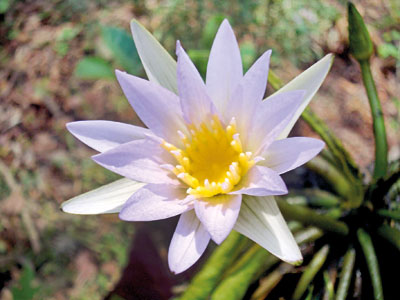Our National flower still embedded in muddy waters

The Nil Manel in all its gentle splendour
The pomp and pageantry are over. The wisps of smoke from the 21 gun-salute have wafted away, carried hither and thither by the gentle winds blowing across the sea at Galle Face Green.
The 69th Independence Day celebrations drew to an end on February 4 but there is a matter of national importance still embedded in muddy waters, awaiting resolution.
It is the matter of the ‘National Flower’ of Sri Lanka into whose prestigious position had crept an imposter flaunting its images and now even though the usurper has been unseated, controversy swirls around an ‘abbreviated’ name.
Earlier, even though the smaller and bluer Nil Manel (Blue Water Lily or Nymphaea nouchali Burm. f) was named as the National Flower, the images adorning all official material from school textbooks to stamps and the government web portal were all of the larger and purple imposter, a hybrid Nymphaea species.
“In November 2010, we pointed out to the then government and all relevant officials that the image used to depict the National Flower is not the right one,” said Prof. Deepthi Yakandawala, Professor in Botany, Department of Botany, Peradeniya Faculty of Science, explaining that the scientific name and the way it was written were also incorrect.
Five years later, on June 10, 2015, a proposal was made through a Cabinet paper by none other than President Maithripala Sirisena in his capacity as Environment Minister to rectify this discrepancy and name the National Flower Manel in Sinhala, Neelothpalam in Tamil and Blue Water Lily in English. The correct scientific name, Nymphaea nouchali Burm. f, and the right image of the flower were also included.
However, for Prof. Yakandawala and husband Dr. Kapila Yakandawala of the Wayamba University who waded into the mud of wewas (tanks) peering closely at these flowers, and first pointed out the faux pas to the country of the wrong image, there is everything in a name, unlike what playwright and poet William Shakespeare penned.
The couple is adamant that the National Flower should be Nil Manel and not just Manel in Sinhala. “The ‘blue’ specifies the colour of the flower and is present in the other two languages of Tamil and English,” says Prof. Yakandawala.
National symbols carry cultural or national values and signify people’s aspirations and speak volumes on the development process and the long years of evolution, she argues, reiterating that as such it is Nil Manel which carries all these values and not just Manel. “This was pointed out by us during numerous discussions on this matter and Nil Manel was to be included in the final document which the committee appointed to study the issue endorsed.”
But, to their astonishment, what blossomed from all the talk and appeared in the final document prepared by the Biodiversity Secretariat coming under the Environment Ministry and submitted to Cabinet in June 2015 was Manel without its all-important prefix ‘Nil’.
When asked, the explanation of the Biodiversity Secretariat had been that they consulted experts on the Sinhala language, who had allegedly said that Nil Manel is incorrect Sinhala as opposed to Manel, she says.
Prof. Yakandawala holds a different and categorical view that no one has the right to change vernacular names (common names in the local language), as they are the names that have been in use for centuries. “To give a botanical name, one should follow rules and regulations governed by the International Code of Nomenclature (ICN), the competent international authority. But for vernacular names no such authority exists. Hence, existing names are used throughout the world. This could be the first time in the history of the world where a vernacular name has been subjected to scrutiny by language specialists.”
Anyone who carries out field work across the country and interacts with people in the villages knows that Nil Manel is the name used by them for this ‘native’ that has dotted wewas from time immemorial, she says.
The Hand Book to the Flora of Ceylon and the Revised Hand Book to the Flora of Ceylon, however, document Manel as the vernacular name for Nymphaea nouchali Burm. f., says this Botanist, adding that the initial book was compiled by the English Botanist Henry Trimen in the 1800s. His field experiences would have been limited and the language barrier restrictive when documenting certain common/vernacular names.
She further argues that Nil Manel was selected as the National Flower by a committee appointed by the government after considering such criteria as ‘utility value’, ‘historical significance’, ‘distribution’, ‘beauty’, ‘being indigenous’ and ‘not being the national flower of another country’.
Sinhala literature, meanwhile, is also replete with references to Nil Manel, with Sandesa poets waxing eloquent about the eyes of maidens, comparing them to this gentle flower.
“Eyes like the Nil Manel,” states the Hansa Sandesaya; “Eyes they set a-flutter are like Nil Manel,” says the Parevi Sandesaya; and “A woman possessing Nil Manel eyes,” adds the Salalihini Sandesaya.
Quoting the official publication of the Central Environmental Authority on the National Flower, Prof. Yakandawala states that among the 108 auspicious signs on the soles of Lord Buddha were two Nil Manel flowers. The Nil Manel is considered an auspicious symbol. The Sigiriya frescoes depict maidens carrying flowers and flower buds which appear to be of the Lotus and the Nil Manel.
This is while the Guttila Kavya’s Stanza 230 bears witness to the fact that the ceremonial chambers used for various occasions were decked with Nil Manel……“Pure white awnings were set up. Garlands of soft Nil Manel were hung on them.”
This flower is also referred to in traditional systems of medicine, says Prof. Yakandawala, urging officials not to drop the lovely Nil Manel into the common pool of Manel, a mix of multiple ‘natives’ and ‘foreigners’, thus stripping it of its value.
“Let’s retain the Nil of this unique bloom,” she adds.


